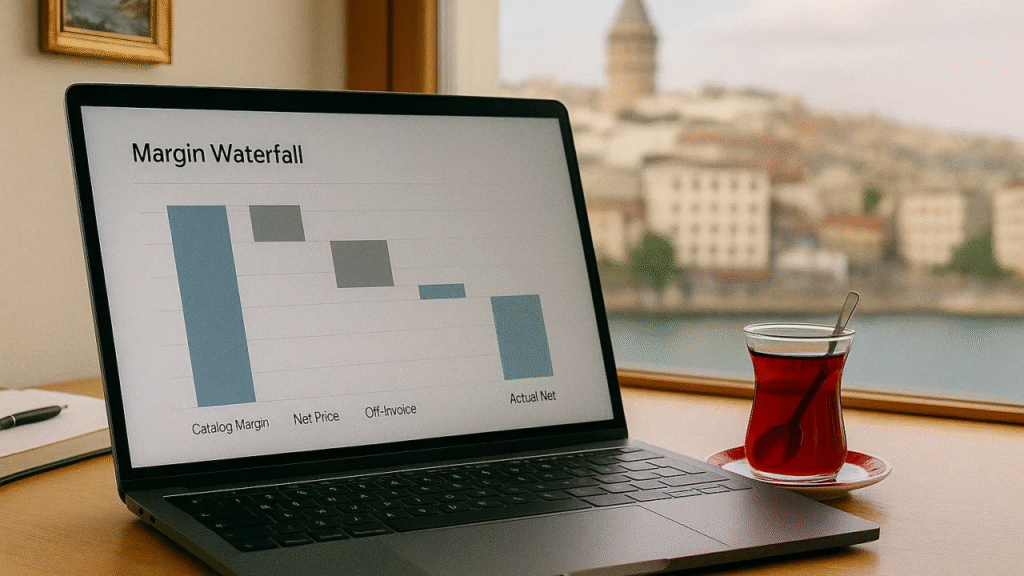
ÖZET (TR)
Türkiye’ye giriş bütçelerinde çoğu model, “informal” kanal ve fatura dışı teşvikleri eksik fiyatlıyor. Saha görüşmeleri + rekabet haritalamasıyla bir Fortune 500’ün ~€2M’luk RTM sapmasını önledik. Yazıda yöntemi, ölçüm çerçevesini ve hibrit ağ tasarımını anlatıyoruz.
How informal channel dynamics quietly distort distribution margins — and how to fix them
Standfirst (deck): Most Turkey-entry budgets treat informal channel dynamics as rounding error. They aren’t. They are the signal that determines your real route-to-market (RTM) cost.
The problem in one line
Most Turkey-entry budgets misprice distribution margins because they treat informal channel dynamics as noise. They aren’t. They are the signal that sets your real RTM cost.
What companies typically miss
- Off-invoice incentives: shelf/placement fees, period-end bonuses, returns, listing fees.
- Cash/early-payment discounts that stack by region and tier.
- Regional sub-distributors beyond metro areas that add hidden layers.
- Grey flows/transit effects that blur the “official” price ladder.
On paper, you plan for X% distributor margin. In the field, these layers can push the actual cost +5–9 points above plan — enough to distort pricing, working capital, and launch ROI.
The case (anonymized)
A Fortune 500 planned a two-tier national distributor network for Turkey. Their budget priced margins using catalog/benchmark values. Our job: stress-test the margin waterfall before contracts.
What we did
- Field interviews across the chain (distributors, sub-distributors, retail buyers, independents).
- Competitive mapping (SKU density by channel/region, promo calendars, logistics constraints).
- Margin waterfall (List → Net → Off-invoice → Actual net, by region/tier).
- RTM scenarios (single national, two-tier national, and hybrid direct + regional).
The overlooked datapoint The model used a single national margin. But in regions reliant on sub-distributor chains, off-invoice + early-payment stacks lifted the real take by >6 points. Aggregated to the planned volumes, that meant a ~€2M RTM overrun in year one.
The fix: redesign the route, reset the incentives
- Hybrid RTM: direct service in metro clusters; selective regional sub-distributors elsewhere.
- Incentive architecture reset: off-invoice items tied to transparent KPI/SLA (SKU penetration, returns, on-time payment).
- Price point re-calibration based on the actual margin waterfall, not the catalog one.
- Data cadence: monthly stock–sellout reconciliation and promo shadowing by region.
Outcome Launch volumes preserved; the ~€2M overrun removed. First-year gross margin +3.2 pts vs. the original plan (client data, anonymized).
A practical 3-week audit you can run before launch
- Week 1: 20–30 structured interviews + quick competitive map (regions, tiers, promo tempo).
- Week 2: Margin waterfall by region/tier; simulate 2–3 RTM architectures.
- Week 3: Final RTM design (hybrid where needed), KPI/SLA pack, and negotiation brief with hard numbers.
Why BKP
- Field-first evidence: access to the right stakeholders, structured interviews, targeted surveys.
- Competitor intelligence: ongoing mapping of price, incentives, and distribution structure.
- Enterprise-grade: proven with Fortune Global 500s and large industrials across Turkey and the region.
Planning a Turkey entry?
Start with a Route-to-Market Audit. In 3 weeks, we’ll surface your actual margin waterfall, de-risk your network design, and protect your launch economics.
Contact: info@bkpconsulting.com • +90 (212) 219 70 66
#RouteToMarket #Distribution #TurkeyMarketEntry #ChannelStrategy #Pricing #CompetitiveIntelligence #B2B #BKPResearch

Hi, this is a comment.
To get started with moderating, editing, and deleting comments, please visit the Comments screen in the dashboard.
Commenter avatars come from Gravatar.